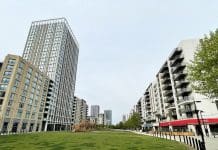Following significant concessions on carbon emission targets in the Approved Documents L to the Building Regulations in both England and Wales, there were serious concerns that Scotland would choose to follow suit with the revisions to Section 6 (energy) of the Building Standards. Instead, the Scottish Government has chosen to fully implement the measures suggested in consultation last year, with a 43% uplift in the carbon reduction target for new non-domestic buildings and a 21% uplift for new domestic properties.
This forward thinking approach keeps the country well on course for its target of achieving Net Zero Carbon on all new buildings by 2017. Set to be implemented next October, Section 6 (energy) 2015 incorporates a wide range of changes and refinements to help meet this target including a clear focus on maximising the performance of the building envelope.
Domestic New Build
As with the 2013 Domestic Technical Handbook, there are two routes to compliance for new domestic buildings. A simplified approach requires dwellings to meet all of the criteria set out within a space heating fuel table, which includes tightened building fabric requirements shown in Figure 1. However, only limited deviations are allowed from the specification and costly renewables are compulsory.
The whole dwelling approach provides greater flexibility. A Target Emission Rate (TER) is calculated based on a ‘notional dwelling’ of the same size and shape as the actual building. A Dwelling Emission Rate (DER) is then calculated for the property and must not exceed the TER. Both of these calculations will be carried out using SAP 2012. To ensure that a high level of thermal performance is achieved as part of any dwelling, the area weighted maximum U-values have also been lowered (Figure 2).
By attaining the best possible U-values it is possible to limit the use of renewables and relax some of the more stringent notional dwelling requirements. Kingspan Insulation has analysed the options and provided recommended building fabric U-values in Figure 2. These will be a little more than is required for some buildings and a little less for others, but provide a good starting point for the majority of applications.
Domestic Refurbishment
The most notable change for retrofit projects centres on improvements in the maximum U-values for dwelling extensions. As shown in Figure 3, extensions to dwellings, which are particularly poorly insulated, must achieve a much higher level of thermal performance.
Compensatory approaches can be used to vary the U-values providing they are within the individual limit; and that overall heatloss is not greater than that of a compliant ‘notional’ extension of the same size and shape. This approach also allows extensions to poorly insulated buildings to be built to the values within column B. A ‘notional’ extension is created using the values in column A with the remaining reduction in heatloss achieved through improvements to the existing building envelope.
It is also now possible to use the whole dwelling approach for retrofits by modelling the existing dwelling and extension to calculate the TER and DER.
Non-Domestic
As with Section 6 2013, the National Calculation Methodology (NCM) is used within an approved tool, typically SBEM, to create a notional building from which a TER is generated. In addition to improving the building fabric performance values for the notional building, the new Standards also allow heated buildings to be separated into zones depending on whether they are naturally or mechanically ventilated.
A Building Emission Rate (BER) is then created based on calculated performance against the notional building. The actual specification can vary from the notional, provided the calculated BER is better than the TER and the limiting requirements are met. Fabric performance is strongly supported with tightened area weighted average U-values, particularly for shell buildings. Again, a recommended starting point for a fabric first approach for non-domestic buildings is provided in figure 5.
The requirements for converted and extended non-domestic buildings remain relatively unchanged from the 2013 standards although extensions with a floor area over 50m2 must comply with the new build Standards.
The Right Choice
By placing a firm emphasis on achieving reduced carbon emissions through fabric performance rather than expensive and often short lived renewables, Section 6 (energy) 2015 should encourage firms to adapt to the new requirements in a cost effective way whilst also keeping homes performing throughout their lifespan.
For further information and technical support please contact:
Tel: +44 (0) 1544 388 601
Fax: +44 (0) 1544 388 888
e.mail: literature@kingspaninsulation..co.uk
website: www.kingspaninsulation.co.uk
www.twitter.com/KingspanIns_UK
www.Google.com/+kingspaninsulationcouk
www.linkedin.com/company/kingspan-insulation-uk
Kingspan Insulation Limited, Pembridge, Leominster, Herefordshire, HR6 9LA
Registered in England & Wales: No. 01882722.
Registered Office: Pembridge, Leominster, Herefordshire HR6 9LA, UK.
VAT GB428602456




















